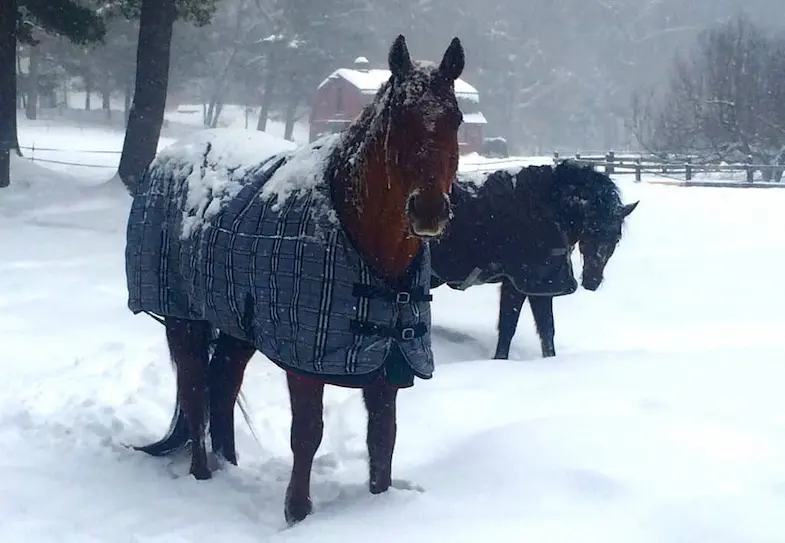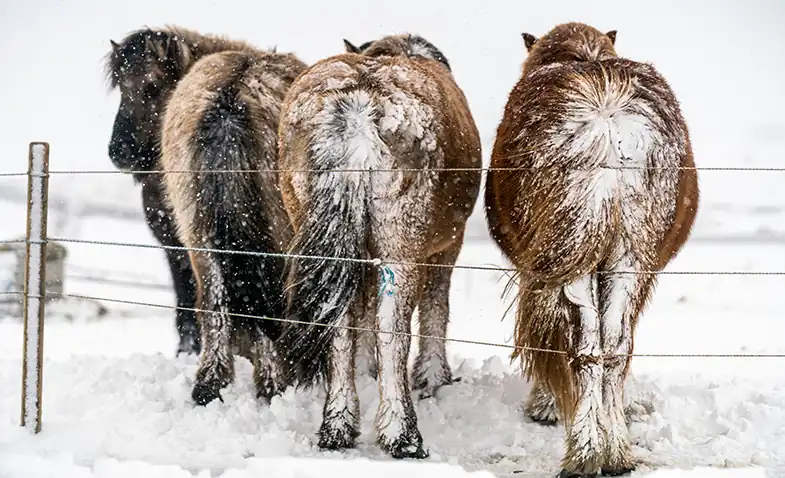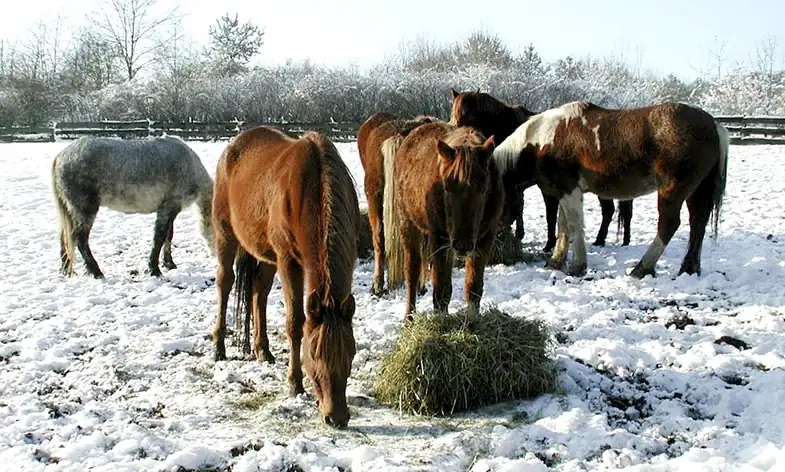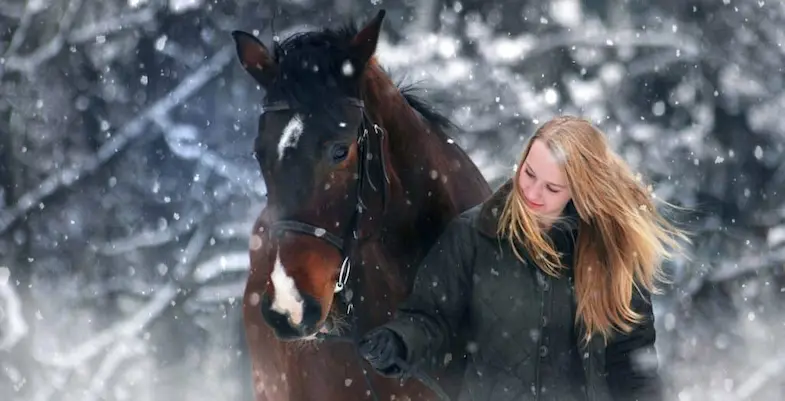I was talking to a friend recently who had just bought her first horse but wasn’t sure whether or not she should be blanketing them during the winter because she didn’t know if he would be cold. This started me thinking about how we can tell if our horses are cold or not.
How can I tell if my horse is too cold? Typically when horses are cold they will shiver and look to huddle with other horses to keep themselves warm, they may even clamp their tail close to their body and turn their back to the wind or rain. Generally, horses can withstand temperatures as low as -40°C (-40°F) but if they’re older or have thin or clipped coats then they’ll get cold much quicker.
Horses are hardy creatures that can easily and quickly adapt to extreme weather conditions (taking just 10 to 21 days on average) which is why they’re perfectly happy living outside during the winter but that doesn’t mean they don’t need a helping hand from time to time.
Do horses feel the cold?
I’m often asked whether or not horses can feel the cold, after all, they’re big creatures that have thick winter coats. While this is obviously true they are also warmblooded mammals so can get cold just as much as any other mammal, although that said they have adapted to be capable of tolerating a far wider range of temperatures than we ever could.
Along with their longer and thicker winter coats, healthy horses also have a good layer of fat that will help to keep them warm during the worst of the winter without the need for blankets. I say healthy horses because those that are underweight or older and horses that have been clipped will need a blanket if the weather’s cold.
Regardless of the horse’s health though, the insulating properties of their coat will be compromised if there’s a heavy downpour or prolonged rain. This is because the rain will flattened their coat and it will no longer able to trap the heat against the horse’s body.
How cold is too cold for a horse?
As a general rule horses don’t start to feel cold until the temperature drops below 0°C (32°F) but as I say this is only a guide. Horses that are used to colder climates probably won’t get cold until the mercury falls below -8°C (17.6°F), whereas horses that are more accustomed to warmer climates will start to feel cold if it drops below 10°C (50°F).
While horses may start to feel cold at around 0°C (32°F) they can live outside in temperatures as low as -40°C (-40°F) if they have a shelter and it’s not raining. Without a shelter then -17.8°C (0°F) is about as low as they can go although most horses (so long as they have a decent winter coat) are happy until the temperature drops below -7.7°C (18°F).
What temperature do horses feel cold at?
Horses are able to thermoregulate their temperature which means that, regardless of the weather, they can keep their core temperature at approximately 38°C (100.4°F). That said though, when the air temperature drops below 0°C (32°F) they start to feel the cold although this can vary from horse to horse.
Age, breed, feeding routine, body condition, and even body size can all play a part in when horses start to feel cold. Ponies, for example, lose less heat than horses while cold-blooded horses won’t lose as much heat as lighter breeds will.
If the ambient temperature is between 0°C (32°F) and 25°C (77°F) horses don’t need any help to keep themselves warm (or cool) but outside of this, they may need extra hay, a shelter, or even a blanket to help them stay warm.
What are the signs of a horse being too cold?
All horses are different and will show different signs of being cold but the main things to look out for are shivering, a drop in their body temperature as well as an increased appetite.
Shivering
Just like us horses will shiver when they get cold. This is a natural response to the cold and is the body’s way of keeping warm. Horses can also shiver if they’re frightened so you should also pay attention to your horse’s overall behavior.
Body temperature
The most reliable way of telling if your horse is cold or not is to use a rectal thermometer to get their actual temperature. Most saddleries and vets will stock rectal thermometers but you can also buy them online from Amazon.
Huddling
In a herd environment horses will huddle together to keep warm and to protect themselves from the elements. While horses will often group together, if they’re huddling closely (with virtually no gaps between them) then there’s a good chance your horse is cold.
Increased appetite
Eating food will help to keep horses warm and they seem to understand this so if your horse is eating more food than normal (especially hay or forage) and you can’t find another reason for it then he’s more than likely cold.
Clamped tail
While horses can tuck their tail close to their body when they’re nervous or apprehensive about something they can also do it when they get cold. They’re effectively reducing the surface area that’s exposed to the cold.
Raised hair
When the weather gets cold horses will raise their hair (like how the hairs on our arms stand up when we’re cold). This helps to trap the warm air under their coats and closer to their skin.
Contrary to popular belief feeling the base of their ears is not a reliable way of gauging a horse’s temperature. This is because they’re often exposed to the elements so can’t be used as an accurate barometer of how cold a horse really is.
How do horses keep themselves warm?
Being outdoor animals horses have evolved to keep themselves warm in extreme cold. Not only do they change their behavior and begin to huddle more but they’re also able to make physical and biological changes too.
Herd protection
They say that the best way to keep warm is to cuddle up close and horses seem to know this. When they get cold or when it’s really windy they’ll turn their backs to the wind and huddle together. This helps them to keep each other warm but also protects their heads from the cold wind.
Foraging
When horses eat their bodies begin to digest the food which helps them to keep warm or to warm up if they’re already cold. This internal heating process is most effective when they’re eating hay because the microbes in the gut produce even more heat when they’re digesting high-fiber foods.
Shelter
If you’ve ever seen horses in a field when it’s cold and wet you’ll undoubtedly have noticed how they stand closer to hedges and tree lines. This natural shelter works as a windbreak which is why horses tend to gather around it. Some horses will even choose to use hedges and tree lines instead of a purpose-built shelter.
Natural insulation
Like a lot of animals, horses grow thicker winter coats that not only help to keep them warm but also work to keep them dry too. The hairs of their coat stand up to trap warm air close to the horse’s skin, this forms an insulating layer which is why you often see unmelted snow on the back of a warm horse.
Metabolic rate
As soon as the temperature drops below 0°C (32°F) horses will lower their metabolic rate to help keep themselves warmer. They will also stop moving around as much and even slow their heart rate down too.
Blood flow
As well as lowering their metabolism rates, horses also reduce the amount of blood flowing to their limbs during the winter. This decrease means that the horse’s limbs can get a lot colder before the rest of the horse does.
How do you warm up a cold horse?
Horses are very good at keeping themselves warm, especially if they’re living in a field with other horses but if your horse isn’t able to do this then you’ll probably have to help him warm up, and keep warm. The best way of doing this is to make sure he’s warm enough to start with which can easily be done by increasing his feed, making sure he’s got plenty of fresh water, and making sure he’s got shelter from the elements.
Increase food
As a general rule horses need around 1.3% more energy for every degree celsius the temperature drops. This is because their bodies are working harder to keep their core at its optimum temperature. While all foods will help your horse to keep warm hay is by far the best as the body produces more heat as it digests high fiber foods.
Warm the water
Even if you’re not heating your horse’s water, just making sure they have enough to drink and are properly hydrated will help them to keep warm. Warming the water beforehand will mean that their bodies don’t need to warm the water itself so can concentrate on keeping the horse warm. If you don’t have a heated water supply you can use an electrically heated bucket to keep the water at the best temperature. There are a variety of different heated buckets on the market but I found this one on Amazon to be the best value, although I’ve never used it myself.
Walk your horse around
I don’t know about you but whenever I complained about being cold when I was younger my mom would always tell me to keep moving. At the time I thought it was just to keep me quiet but now I realize that moving is one of the best ways to warm a horse (or yourself) up. Even just walking your horse around slowly will get their muscles working which will, in turn, keep them warm. Don’t exercise them too much though otherwise, you run the risk of making them sweat which will make them colder.
Bring them in
If you have access to a warm, draft free stall you can bring your horse in until he’s warmed up. You should also make sure he has plenty of hay and warm water while he’s inside too.
Remove excess moisture
If your horse is cold because he’s wet then it’s important to make sure he’s completely dry and out of the wind. The best way to do this is to bring him into a warm, draft free stall and use towels to remove as much moisture as possible.
Blanket when necessary
If you don’t have access to a stall (or your horse is still cold while he’s inside) then you can use blankets to help warm him up. It’s important though that you don’t over blanket him otherwise you can warm him up too quickly and cause him to sweat. Instead, start with a light blanket and add another one later if necessary.
What happens if a horse is too cold?
While horses are generally good at keeping themselves warm they can suffer from hypothermia if their core temperature drops below 37°C (99°F) which can be very serious.
If you think your horse is too cold and suffering from hypothermia you should call your vet immediately. Hypothermia can lead to heart trouble, organ failure and can, in some cases, be fatal. They will be able to tell you how best to warm your horse up while they’re on their way. Your vet will also ask you what your horse’s vital signs are so that they know when they’re okay.
Most of the time you can warm your horse up by following the tips in this article but in some extreme cases, it’s not advisable to warm them up from the outside. Instead, your vet will give the horse warm fluids while monitoring them for signs of organ damage.
Are horses okay to stay outside during the winter?
Horses are social animals that are far happier when they’re living outside with other horses which is why it’s always better to leave them outside during the winter unless the weather is well below freezing. In fact, some horses can become very stressed if they’re brought inside for prolonged periods of time, regardless of the weather.
As long as a horse is healthy and in good condition there’s no reason at all why you should bring them in during the winter, they’ll generally be happier if they are outside. If, however, your horse is suffering from an injury, illness, or is underweight then it might be better to bring them in, even if only at night time when the weather is at its coldest.
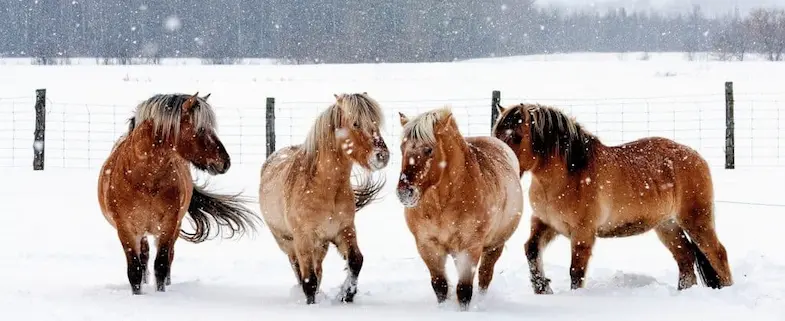
Related questions
When do horses get their winter coats?
You might think that horses get their winter coats as soon as the weather turns colder, but they actually start to grow them at the end of the summer. Towards the end of August, they begin to shed their shorter summer coats which are replaced by a much longer and thicker winter coat ready for the winter.
Do older horses feel the cold more?
Just like people, when horses get older their skin gets thinner and their metabolism changes, both of which make it harder for them to keep warm during the winter. The same is true for thinner skinned horses and those that are underweight. This is the main reason why many older horses need to be blanketed throughout the winter.
Does eating hay keep horses warm?
When horses eat (regardless of what they’re eating) their bodies are constantly producing heat. This is because their digestive system generates heat as it works to break down and digest the food (which is why we talk about burning calories). This will help them to maintain their body temperature during the winter. While heat is produced in the digestion of most foods, it’s high-fiber foods such as hay and forage that produce the most amount of heat.
Further reading
- Caring for a horse: a beginner’s guide
- Can horses cope with the rain?
- Stay safe while riding in the snow
- Should you stable your horse at night?
- Beating your horse’s stall rest blues
- Do I really need to clip my horse?
- Preparing your horse for winter
- Can I keep a horse in my backyard?
- Should you feed your before riding?
- How to stop your horse overheating
I hope you found this article helpful. If you did I’d be grateful if you could share it please as it would really help me.
Recommended products
Over the years I have tried hundreds of different horsey products, from various blankets and halters to different treats. Some I’ve loved, others I’ve hated but I thought I’d share with you my top all-time favorite products, the ones I never leave the yard without. I’ve included links to the products (which are in no particular order) that I really think are great.
- Horse Knots by Reference Ready – If you’re like me and enjoy pocket reference guides then you’ll love this knot tying guide. These handy cards can easily fit in your pocket or attach to the saddle for quick reference. They’re waterproof, durable and are color coded to make them easy to follow.
- Mane ’n Tail Detangler – Even if you never show your horse you’ll need to detangle his tail from time to time (and possibly his mane too) which is always a challenging chore! I’ve found that if I run a little bit of detangler through my horse’s tails every few days it stops them from getting matted up and makes combing them easy, even if they’re coated in mud. I don’t know if I should admit to this or not but it also works wonders on my hair.
- TAKEKIT Pro clippers – Over the years I’ve tried a lot of different clippers and while some were obviously better than others I found these to be by far the best. They are heavier than a lot of other clippers but for me, that’s a good thing, it makes them feel more sturdy and hardwearing. On top of that they have a range of speeds so are just as good for clipping your horse’s back as they are his face. I also like the fact that they come in a handy carry case but that’s not for everybody. The company that makes them is super good and incredibly helpful too, a real bonus these days. The only thing I wasn’t keen on was the fact that it doesn’t come with any oil, but that’s not a major problem as it’s not difficult to buy lubricant.
- Shire’s ball feeder – There are so many boredom buster toys out there but I like to use these every day, regardless of whether or not my horses are bored. I find that it helps to encourage my horses to problem solve by rewarding them with treats (or pieces of fruit) but it also mimics their natural grazing behavior which helps to keep them calm and de-stressed.
- Horse safe mirror – This is a strange one that many people are surprised about but I like to put horse safe mirrors in the trailers as well as in the quarantine stalls. It helps to prevent the feeling of isolation by giving the impression of other horses being around. Being herd animals horses can get extremely stressed when they feel that they’re on their own but with these stick-on mirrors, they believe that at least one other horse is with them.
- Rectal thermometer – I know this isn’t glamourous at all but it’s vital for your horse’s well-being to be able to check their temperature and a rectal thermometer is the easiest way of doing this which is why I’ve added it to the list.
Shopping lists
I’ve also put together a few shopping lists of essential items that I’ve found helpful over the years. I’ve broken the lists down into different categories rather than put everything in one massive list 😉

